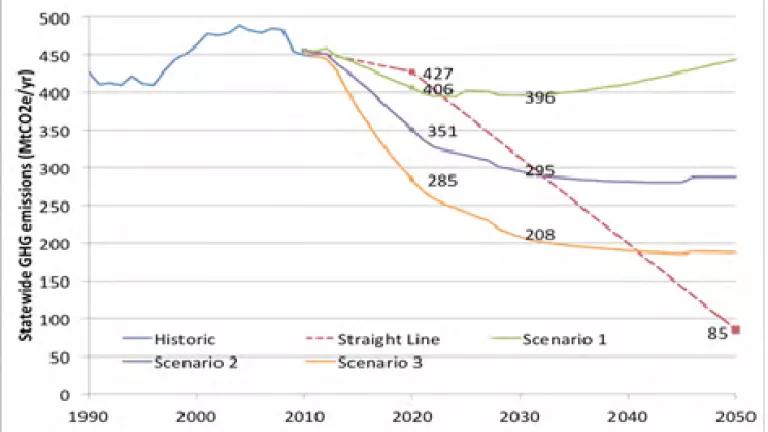
A new study commissioned by the California Air Resources Board projects California will come in well under the 2020 carbon pollution limit established in the landmark Global Warming Solutions Act (AB 32), and has the policy framework in place today to get a significant head start toward achieving the state’s long-term emission reduction goals.
The Lawrence Berkeley National Laboratory report also concludes the state will need to expand upon its current suite of policies and targets over the next 20 to 30 years to achieve the 2050 goal of reducing emissions 80 percent below 1990 levels.
This should come as no surprise, yet several media outlets seized upon the latter finding to suggest California won’t meet its 2050 goals or, more cynically, that California’s emission reduction goals are ‘hopeless’ and ‘unattainable’ (and presumably therefore not worth pursuing).
These reports grossly misconstrue the purpose of the study. Rather than work backward from a 2050 reduction target, this study was the first to examine California’s near- and mid-term emissions trajectories under three scenarios designed to reflect the state’s existing policy landscape:
- What’s currently on the books (“committed policies” such as the state’s Renewable Portfolio Standard, Pavley clean cars standards, and energy efficiency programs);
- What’s on the books plus what’s been proposed as additional targets (“uncommitted policies” such as the state’s zero net energy homes initiative and Governor Brown’s 12,000 megawatt distributed generation goal); and
- Committed policies plus uncommitted policies plus a handful of potential technology and market advancements that go beyond current state goals (such as higher penetration levels of zero emission vehicles and faster phase out of high global warming potential gases).
On Track for AB 32 Limit
The analysis finds that under every scenario, California will readily achieve AB 32’s overarching goal of reducing statewide emissions to 1990 levels by 2020. For one of the largest economies in the world, this foreshadows a truly remarkable feat.
Framework in Place to Continue Reductions Beyond 2020
The study also shows California has much of the policy framework in place today to continue emission reductions beyond 2020 at a clip consistent with the ‘midpoint’ target the state has called for establishing in 2030. Taking just the light-duty transportation sector, for instance, California’s largest source of emissions, the study projects the state’s current suite of policies will cut emissions in half from today’s levels by 2030. By maintaining progress beyond the current ”life” of those committed policies, by extending the Low Carbon Fuel Standard beyond 2020 for example and continuing to improve vehicle efficiency at current levels, the state will be well on its way toward meeting an 80% reduction in the transportation sector.
Note also the study does not model the extension of California’s economy-wide cap-and-trade program beyond 2020, which the Air Board has already signaled it will begin developing. Extending the cap will require emitters to continue finding innovative approaches to cut pollution and prevent emissions from rebounding due to population and economic growth (which the model currently projects, as seen in the figure above).
The (Long) View to 2050
Multiple independent studies have already concluded California can achieve its 2050 reduction target relying chiefly on existing technology (including a report from the same LBNL research team). Unlike those studies, which modeled various policy and technology pathways around a fixed reduction target, LBNL’s latest offering gauges how far California can get on the road to 2020 and beyond relying on its existing strategies.
The answer? A long, long way. The study conclusively finds California is on track to meet AB 32’s 2020 goal, and well-positioned to make progress out to 2030 by extending the policy framework it already has in place. While the state will need to continue pioneering new strategies to keep pace over the long-run, California’s progress thus far is certainly something to celebrate.
